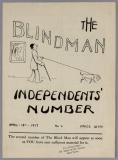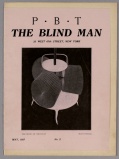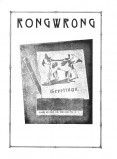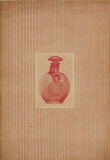Marcel Duchamp
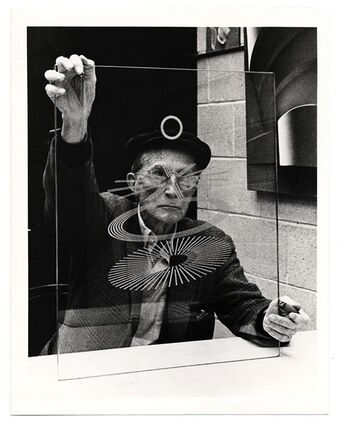 Richard Hamilton, Marcel Duchamp, 1967. Lithograph on paper. 80 x 59 cm. [1] | |
| Born |
July 28, 1887 Blainville, France |
|---|---|
| Died |
October 2, 1968 (aged 81) Neilly-sur-Seine, France |
| Web | UbuWeb Film, UbuWeb Sound, Dada Companion, Aaaaarg, Wikipedia, Academia.edu, Open Library |
| Collections | Pompidou 419 +, PhilArt 113, Boijmans 62, IM Jerusalem 53, MoMA 44, Met 22, Whitney 21, Macba 16, Artic 13, Tate 11, LACMA 10, NGS 6, Reina Sofia 6, MAM 5, SFMOMA 4, Stedelijk 3, SG Stuttgart 3, Guggenheim 3, NGA 3, IMMA 3, KM Basel 2, Van Abbe 2, Guggenheim Venice 2, MiA 2, MA Cleveland 2, NRW 1 |
Henri Robert Marcel Duchamp (1887-1968) was a painter, sculptor, chess player, and writer whose work is associated with Dada, avant-garde and conceptual art.
In 1904, he joined his artist brothers, Jacques Villon and Raymond Duchamp-Villon, in Paris, where he studied painting at the Académie Julian until 1905. Duchamp’s early works were Post-Impressionist in style. He exhibited for the first time in 1909 at the Salon des Indépendants and the Salon d’Automne in Paris. His paintings of 1911 were directly related to Cubism but emphasized successive images of a single body in motion. In 1912, he painted the definitive version of Nude Descending a Staircase; this was shown at the Salon de la Section d’Or of that same year and subsequently created great controversy at the Armory Show in New York in 1913.
Duchamp’s radical and iconoclastic ideas predated the founding of the Dada movement in Zurich in 1916. By 1913, he had abandoned traditional painting and drawing for various experimental forms, including mechanical drawings, studies, and notations that would be incorporated in a major work, The Bride Stripped Bare by Her Bachelors, Even (1915–23; also known as The Large Glass). In 1914, Duchamp introduced his readymades—common objects, sometimes altered, presented as works of art—which had a revolutionary impact upon many painters and sculptors. In 1915, Duchamp traveled to New York, where his circle included Katherine Dreier and Man Ray, with whom he founded the Société Anonyme in 1920, as well as Louise and Walter Arensberg, Francis Picabia, and other avant-garde figures.
After playing chess avidly for nine months in Buenos Aires, Duchamp returned to France in the summer of 1919 and associated with the Dada group in Paris. In New York in 1920, he made his first motor-driven constructions and invented Rrose Sélavy, his feminine alter ego. Duchamp moved back to Paris in 1923 and seemed to have abandoned art for chess but in fact continued his artistic experiments. From the mid-1930s, he collaborated with the Surrealists and participated in their exhibitions. Duchamp settled permanently in New York in 1942 and became a United States citizen in 1955. During the 1940s, he associated and exhibited with the Surrealist émigrés in New York, and in 1946 began Etant donnés: 1. la chute d’eau 2. le gaz d’éclairage, a major assemblage on which he worked secretly for the next 20 years. [2]
Publications[edit]
Magazines[edit]
Blindman 1, Apr 1917, PDF
The Blind Man 2, May 1917, PDF
Rongwrong, Jul 1917, JPGs
New York Dada, Apr 1921, PDF
- The Blind Man, with Beatrice Wood and Henri-Pierre Roché, 2 issues, New York: Henri Pierre Roché, 1917. (English)
- Rongwrong, with Beatrice Wood and Henri-Pierre Roché, 1 issue, New York, 1917. (French)
- New York Dada, with Man Ray, 1 issue, 1921. (English)
Editor[edit]
- as Rrose Sélavy, Some French Moderns Says McBride, New York: Société Anonyme, 1922, 18 sheets. A collection of essays by the art editor and critic Henry McBride, published in the New York Sun and the New York Herald, 1915-1922, compiled and designed by Duchamp. (English)
- International Exhibition of Modern Art, with Katherine S. Dreier and Man Ray (as Société Anonyme), New York: Société Anonyme and Museum of Modern Art, 1926, 124 pp. Catalogue. (English)
Pamphlets[edit]
- L'opposition et les cases conjuguées sont réconciliées par / Opposition und Schwesterfelder sind versöhnt durch / Opposition and Sister Squares are reconcilied by Duchamp et Halberstadt, Paris and Brussels: L'Échiquier, 1932, 112 pp. [3]
- Rrose Sélavy, Paris: GLM, 1939. A short book of puns and word games.
Notes[edit]
- The Bride Stripped Bare by her Bachelors Even (The Green Box), Paris: Rrose Sélavy, 1934. Notes on scraps of paper explaining Duchamp's The Bride Stripped Bare by Her Bachelors, Even (The Large Glass) (1915-23). [4] (English)
- À l'infinitif [The White Box], New York: Cordier & Ekstrom, 1966, 32 pp; new ed., Cologne: König, 1999. Seventy-nine previously unpublished notes from 1912-20. [5] (English)
- Notes and Projects for the Large Glass, ed. & intro. Arturo Schwarz, New York: H.N. Abrams, 1969; London: Thames & Hudson, 1969. (English)
Talks[edit]
- "The Creative Act" [1957], Art News 56:4, New York, Summer 1957; repr. in The Essential Writings of Marcel Duchamp, 1975, pp 138-140. Given in Houston at the meeting of the American Federation of the Arts, Apr 1957. Duchamp, who labeled himself as a "mere artist", participated in a roundtable with William C. Seitz of Princeton U, Rudolf Arnheim of Sarah Lawrence College, and Gregory Bateson.
- "Le processus créatif", trans. Marcel Duchamp, in Marchand du sel, 1959. (French)
- "Il processo creativo", trans. Michele Zaffarano, n.d. (Italian)
- "Apropos of 'Readymades'" [1961], Art and Artists 1:4, London, Jul 1966, p 47; repr. in The Essential Writings of Marcel Duchamp, 1975, pp 141-142. Given at the Museum of Modern Art, New York, 19 Oct 1961.

Catalogues[edit]
- Jacques Villon, Raymond Duchamp-Villon, Marcel Duchamp, New York: Solomon R. Guggenheim Museum, and Houston: Museum of Fine Arts, 1957. (English)
- The Almost Complete Works of Marcel Duchamp, ed. Richard Hamilton, London: Arts Council of Great Britain, 1966. Catalogue of an exhibition at the Tate Gallery, 18 June-31 July 1966. (English)
- Marcel Duchamp, eds. Anne d'Harnoncourt and Kynaston McShine, New York: Museum of Modern Art, and Philadelphia: Philadelphia Museum of Art, 1973, 345 pp, PDF. Retrospective exhibition. (English)
- The Complete Works of Marcel Duchamp, ed. Arturo Schwarz, New York: H.N. Abrams, 1969; 2nd ed., rev., 1960, 630 pp, 3rd ed., rev. & exp., 2 vols., text Arturo Schwarz, eds. Jane Fluegel, Barbara Ross Geiger and Helen M. Franc, New York: Delano Greenidge, 1997, vii+974 pp. [6] (English)
- Marcel Duchamp: Work and Life, ed. & intro. Pontus Hulten, MIT Press, 1993, 650 pp. Texts by Jennifer Gough-Cooper and Jacques Caumont; with 1,200 illustrations; published as the catalogue to the Palazzo Grassi (Venice) exhibition in June 1993. (English)
- Marcel Duchamp, ed. Susanne Pfeffer, Frankfurt: Museum für Moderne Kunst, 2022, 850 pp. [7] (English)
- Marcel Duchamp, Frankfurt: Museum für Moderne Kunst, 2022, 850 pp. (German)
- Marcel Duchamp, Frankfurt: Museum für Moderne Kunst, 2022, 850 pp. (French)

Collected writings[edit]
- Marchand du sel: Écrits de Marcel Duchamp, ed. Michel Sanouillet, Paris: Terrain vague, 1959; new ed., corr. & augm., as Duchamp du signe: écrits, ed. Michel Sanouillet with Elmer Peterson, Paris: Flammarion, 1976, 314 pp; 1994. (French)/(English)
- Marchand du sel, intro. Alberto Boatto, trans. Anna Nosei Weber, Salerno: Rumma, 1969, 150 pp. (Italian)
- Salt Seller: The Writings of Marcel Duchamp, eds. Michel Sanouillet and Elmer Peterson, New York: Oxford University Press, 1973; UK ed. as The Essential Writings of Marcel Duchamp, London: Thames and Hudson, 1975, 195 pp; repr. as The Writings of Marcel Duchamp, Da Capo Press, 1989. (English)
- Escritos: Duchamp du signe, trans. Josep Elias and Carlota Hesse, Barcelona: Gustavo Gili, 1978, 254 pp; new ed. as Escritos: Duchamp del signo, seguido de notas, ed. José Jiménez, Barcelona: Galaxia Gutenberg, 2012, 556+32 pp. (Spanish)
- Mercante del segno, trans. Achille Bonito Oliva, Cosenza: Lerici, 1978, x+260 pp. (Italian)
- Die Schriften, 1. Zu Lebzeiten veröffentlichte Texte, trans., comm. & ed. Serge Stauffer, Zurich: Regenboden, 1981. (German)
- Marcel Duchamp: izbor tekstova, ed. Zoran Gavrić, trans. Branislava Belić, Belgrade: Muzej savremene umetnosti, 1984, 47 pp. (Serbo-Croatian)
- Marcel Duchamp: spisi: tumačenja, eds. Zoran Gavrić and Branislava Belić, Bogovađa: Samostalno izdanje, 1995, 395 pp. (Serbian)
- Works, Writings, Interviews, Poligrafa, 2009, 160 pp. [8] (English)


Interviews[edit]
- Interview with James Johnson Sweeney, in Wisdom: Conversations with the Elder Wise Men of Our Day, ed. James Nelson, New York: W.W. Norton, 1958, pp 89-99. Conducted late 1955 in the Philadelphia Museum of Art. (English)
- Pierre Cabanne, Etretiens avec Marcel Duchamp, Paris: Pierre Belfond, 1967, 218 pp; Allia, 2014, 160 pp. [9] (French)
- Dialogues with Marcel Duchamp, trans. Ron Padgett, London: Thames and Hudson, 1971; Da Capo Press, 1987, 136 pp. (English)
- Gespräche mit Marcel Duchamp, trans. Harald Schmunk and Ursula Dreysse, Cologne: Galerie der Spiegel, 1972, 168 pp. (German)
- Dialog med Duchamp, trans. Jan Östergren, Lund: Cavefors, 1977, 149 pp. (Swedish)
- Gesprekken met Marcel Duchamp, trans. Chris Van de Poel, Amsterdam: Meulenhoff/Leuven: Kritak, 1991, 184+16 pp. (Dutch)
- Az eltűnt idő mérnöke: beszélgetések, trans. Tészabó Júlia, Budapest: Képzőművészeti, 1991, 254+16 pp. (Hungarian)
- Du shang fang tan lu [杜尚访谈录], Beijing: Wen hua yi shu chu ban she, 1997. (Chinese)
- Dushan wa kataru [デュシャンは語る], Tokyo: Chikuma Shobo, 1999, 241 pp. (Japanese)
- with Calvin Tomkins, The Afternoon Interviews, Badlands Unlimited/National Philistine, 2013, 110 pp. Conducted 1964 in New York. (English)
- Poslepoludennye besedy [Послеполуденные беседы], trans. Sergey Dubin, Moscow: Griundrisse, 2014, 158 pp. (Russian)
Bibliography[edit]
- Bernard Karpel, "Selected Bibliography", in Pierre Cabanne, Dialogues with Marcel Duchamp, Da Capo Press, 1987, pp 121-132. (English)
- Timothy Shipe, "Marcel Duchamp: A Selective Bibliography", Dada/Surrealism 16 (1987), pp 231-265; upd. in The Complete Works of Marcel Duchamp, 3rd ed., ed. Arturo Schwarz, New York, 1997; upd., with Kathryn M. Floyd, in Etant donné Marcel Duchamp, 2003, pp 5ff. (English)
Literature[edit]
Monographs[edit]
- Robert Lebel, Sur Marcel Duchamp, Paris: Trianon, 1959, 193 pp. With chapters by Marcel Duchamp, André Breton and H.P. Roché. (French)
- Marcel Duchamp, trans. George Heard Hamilton, New York: Grove Press, 1959, 201 pp. (English)
- Calvin Tomkins, The World of Marcel Duchamp, 1887–1968, New York: Time-Life Books, 1966; rev.ed., 1972, Log. Draws on interviews and materials gathered for Tomkins’ 1965 profile of Duchamp in The New Yorker. (English)
- De wereld van Marcel Duchamp: 1887-1968, trans. A. Korteweg, Amsterdam: Het Parool, 1970, 191 pp. (Dutch)
- Marcel Duchamp und seine Zeit: 1887-1968, trans. Franziska Weidner and John Frederick Gorrissen, Amsterdam: Time-Life International, 1973, 191 pp. (German)
- Octavio Paz, Marcel Duchamp o El castillo de la pureza, México: Era, 1968, 62 pp. (Spanish)
- Marcel Duchamp or The Castle of Purity, trans. Donald Gardner, New York: Grossman, 1970; London: Cape Goliard Press, 1970; new ed. as Marcel Duchamp: Appearance Stripped Bare, trans. Rachel Phillips and Donald Gardner, New York: Viking Press, 1978, vii+211 pp, ARG; repr., Arcade, 2014, EPUB. (English)
- "Marcel Duchamp ou le château de la pureté", trans. Monique Fong-Wust, in Paz, Deux transparents: Marcel Duchamp et Claude Lévi-Strauss, Paris: Gallimard, 1970. (French)
- Meztelen jelenés: Marcel Duchamp, trans. Somlyó György, Budapest: Helikon, 1990, 164 pp. (Hungarian)
- John Golding, Marcel Duchamp: The Bride Stripped Bare by her Bachelors, Even, New York: Viking Press, 1973, 116 pp, PDF; London: Allen Lane, 1973. (English)
- Jean Clair, Marcel Duchamp ou le Grand fictif: essai de mythanalyse du Grand verre, Paris: Galilée, 1975, ARG. (French)
- Jean-François Lyotard, Les transformateurs Duchamp, Paris: Galilée, 1977. (French)
- Die Transformatoren Duchamp, trans. Regine Bürkle-Kuhn, Stuttgart: Galerie Kubinski, 1986, 138 pp. (German)
- Duchamp’s TRANS/formers, trans. Ian McLeod, Venice, CA: Lapis Press, 1990, 208 pp, Log. (English)
- I transformatori Duchamp: studi su Marcel Duchamp, trans. Elio Grazioli, Cernusco L: Hestia, 1992, xiii+129 pp. (Italian)
- Thierry de Duve, Nominalisme pictural: Marcel Duchamp, la peinture et la modernite, Paris: Minuit, 1984. (French)
- Pikturaler Nominalismus. Marcel Duchamp: die Malerei und die Moderne, trans. Urs-Beat Frei, Munich: Silke Schreiber, 1987, 268 pp. (German)
- Pictorial Nominalism: On Marcel Duchamp's Passage from Painting to the Readymade, foreword John Rajchman, trans. Dana Polan, University of Minnesota Press, 1991, 222 pp, PDF. (English)
- Maruseru dushan: Kaiga yuimeiron o megutte, trans. Kamata Hiroo, 298+31 pp. (Japanese)
- Thierry de Duve, Résonances du readymade: Duchamp entre avant-garde et tradition, Nîmes: Jacqueline Chambon, 1989, 301 pp. (French)
- Thierry de Duve (ed.), The Definitively Unfinished Marcel Duchamp: Colloquium: Revised papers, MIT Press, 1991, 550 pp, PDF.
- Dalia Judovitz, Unpacking Duchamp: Art in Transit, University of California Press, 1995, HTML. (English)
- Calvin Tomkins, Duchamp: A Biography, New York: Museum of Modern Art, 1996; 2014. PDF (pp 1-43). (English)
- Duchamp, trans. Mónica Martín Berdagué, Barcelona: Anagrama, 1999, 639 pp. (Spanish)
- Marcel Duchamp : eine Biographie, trans. Jörg Trobitius, Munich: Hanser, 1999, 600 pp. (German)
- Duchamp: biografia, trans. Iwona Chlewińska, Poznań: Zysk i S-ka. Wydaw., 2001, 485 pp. (Polish)
- Duchamp: uma biografia, pref. Paulo Venâncio Filho, trans. Maria Theresa de Resende Costa, São Paulo: Cosac Naify, 2004, 586 pp. (Brazilian Portuguese)
- Thierry de Duve, Kant nach Duchamp, trans. Urs-Beat Frei and Michael von Killisch-Horn, Munich: K. Boer, 1993, 360 pp. Revised and expanded version of de Duve's Au nom de l'art (1989) and Résonances du readymade (1989). (German)
- Juan Antonio Ramírez, Duchamp, el amor y la muerte, incluso, Madrid: Siruela, 1993, 309 pp. Excerpt. (Spanish)
- Amelia Jones, Postmodernism and the En-Gendering of Marcel Duchamp, Cambridge University Press, 1994, xx+316 pp, ARG. (English)
- Jerrold Seigel, The Private Worlds of Marcel Duchamp: Desire, Liberation, and the Self in Modern Culture, University of California Press, 1997, HTML.
- Jindřich Chalupecký, Úděl umělce. Duchampovské meditace, afterw. Pavla Pečinková, Prague: Torst, 1998, 456 pp, Log. (Czech)
- A művész sorsa: Duchamp-meditációk, Budapest: Balassi, 2002, 270+64 pp. (Hungarian)
- Dawn Ades, Neil Cox, David Hopkins, Marcel Duchamp, London: Thames & Hudson, 1999, PDF; 2nd ed., 2021, EPUB; 3rd ed., 2022, EPUB. (English)
- David Joselit, Infinite Regress: Marcel Duchamp 1910-1941, MIT Press, 2001, 262 pp, ARG. [10] (English)
- Alice Goldfarb Marquis, Marcel Duchamp: The Bachelor Stripped Bare, Boston: MFA Publications, 2002, 368 pp, Log. (English)
- John F. Moffitt, Alchemist of the Avante-Garde: The Case of Marcel Duchamp, SUNY Press, 2003, 468 pp, Log. (English)
- Theo Steiner, Duchamps Experiment. Zwischen Wissenschaft und Kunst, Munich: Fink, 2006, JPG, PDF. (German)
- Herbert Molderings, Kunst als Experiment. Marcel Duchamps "3 Kunststopf-Normalmaße", Munich: Deutscher Kunstverlag, 2006, 192 pp. (German)
- L'art comme expérience: les 3 stoppages étalon de Marcel Duchamp, trans. Anne-Marie Geyer, Paris: Editions de la Maison des sciences de l'homme, 2007, 198 pp. (French)
- Duchamp and the Aesthetics of Chance: Art as Experiment, trans. John Brogden, New York: Columbia University Press, 2010, PDF, ARG. (English)
- T.J. Demos, The Exiles of Marcel Duchamp, MIT Press, 2007, 303 pp, ARG. (English)
- Bernard Marcadé, Marcel Duchamp: La vie à crédit: Biographie, Paris: Editions Flammarion, 2007, 595 pp, (French)
- Dalia Judovitz, Drawing on Art: Duchamp and Company, University of Minnesota Press, 2010, ARG. (English)
- Stefan Banz (ed.), Marcel Duchamp and the Forestay Waterfall: Symposium, Concert, Intervention, Exhibitions, Zürich: JRP/Ringier, 2010, 408 pp. (English)
- Giovanna Zapperi, L'artiste est une femme. La modernité de Marcel Duchamp, Paris: PUF, 2012, 152 pp. Review: Décimo (Critique d'art). [11] (French)
- L'artista è una donna. La modernità di Marcel Duchamp, Verona: Ombre Corte, 2014. (Italian)
- Penelope Haralambidou, Marcel Duchamp and the Architecture of Desire, Ashgate, 2013. (English)
- Stefan Banz, Marcel Duchamp: 1° La Chute D’eau, Nürnberg: Verlag für moderne Kunst, 2013, 364 pp. [12] (French)/(German)/(English)
- Stefan Banz, Marcel Duchamp: Pharmacie, Nürnberg: Verlag für moderne Kunst, 2013, 308 pp. [13] (German)/(English)
- Ernst Strouhal, Marcel Duchamp & Vitaly Halberstadt: A Game in a Game, Nürnberg: Verlag für moderne Kunst, 2013, 176 pp. [14] (French)/(German)/(English)
- 3 New York Dadas and the Blind Man: Marcel Duchamp, Henri-Pierre Roché, Beatrice Wood, London: Atlas, 2014. [15] (English)
- Jeff Wall, Marcel Duchamp: Étant donnés, intro. Michael R. Taylor, afterw. Stefan Banz, Nürnberg: Verlag für moderne Kunst, 2014, 152 pp. [16] (French)/(English)/(German)
- Lars Blunck, Marcel Duchamp: Porte-bouteilles, Nürnberg: Verlag für moderne Kunst, 2014, 132 pp. [17] (German)/(English)
- Didier Semin, Duchamp: The Paradigm of the Cartoon, Vienna: Verlag für moderne Kunst, 2016, 116 pp. [18] (French)/(English)/(German)
- Stefan Banz, Louis Michel Eilshemius und sein Einfluss auf Marcel Duchamp, forew. Ugo Rondinone, Vienna: Verlag für moderne Kunst, 2016, 288 pp. [19] (German)
- Maurizio Lazzarato, Marcel Duchamp et le refus du travail, suivi de Misère de la sociologie, Paris: Éditions Les Prairies ordinaires, 2014, 87 pp. ARG. Review (French)
- Anne Collins Goodyear, James W. McManus (eds.), aka Marcel Duchamp: Meditations of the Identities of an Artist, Smithsonian Institution Scholarly Press, 2014, 277 pp. Review: Judovitz (Biography). [21] (English)
- Elena Filipovic, The Apparently Marginal Activities of Marcel Duchamp, MIT Press, 2016, 360 pp. [22]. Reviews: Costantini (Leonardo), Doove (Leonardo). (English)
- Jacquelynn Baas, Marcel Duchamp and the Art of Life, MIT Press, 2019, 400 pp. [23] (English)
- Herbert Molderings, Über Marcel Duchamp und die Ästhetik des Möglichen, Cologne: Verlag der Buchhandlung Walther König, 2019, 360 pp. (German)
- Anna Markowska, Dlaczego Duchamp nie czesal sie z przedzialkiem [Why Duchamp Didn't Part His Hair], Universitas, 2019, 516 pp, ARG. [24] (Polish)
- Celia Rabinovitch, Duchamp's Pipe: A Chess Romance--Marcel Duchamp and George Koltanowski, Penguin, 2020, 256 pp, ARG. (English)
- Adina Kamien-Kazhdan, Remaking the Readymade: Duchamp, Man Ray, and the Conundrum of the Replica, Routledge, 2020, 392 pp, ARG. (English)
Book chapters, essays[edit]
- Calvin Tomkins, "Marcel Duchamp", in The Bride and the Bachelors: Five Masters of the Avant-Garde, Viking, 1965; new ed., exp., new intro., Viking, 1968; Penguin, 1976, 306 pp. (English)
- Anne d'Harnoncourt, Walter Hopps, "Étant Donnés: 1° la chute d'eau, 2° le gaz d'éclairage: Reflections on a New Work by Marcel Duchamp", Philadelphia Museum of Art Bulletin 64:299/300, Philadelphia Museum of Art, Apr-Sep 1969, pp 5-58. (English)
- Laurent Sauerwein, "Remembering Marcel and Duchamp", Toufait, 2007. (English)
- Matěj Strnad, "Anémic Cinéma – Vybrané osudy", Sešit pro umění, teorii a příbuzné zóny 22, Prague, 2017, pp 22-41. (Czech)
- more on Toutfait
Journal issues[edit]
- View 5(1): "Marcel Duchamp", ed. Charles Henri Ford, New York, Mar 1945. [25] (English)
- Sešity pro literaturu a diskusi 4(29): "Marcel Duchamp", Mar 1969. (Czech)
- October 70: "The Duchamp Effect", MIT Press, Fall 1994, 146 pp, ARG. (English)
Dissertations[edit]
- Lars Blunck, Duchamps Präzisionsoptik, Munich: Silke Schreiber, 2008, 351 pp. [28] (German)
- Elena Filipovic, The Apparently Marginal Activities of Marcel Duchamp, Princeton University, 2013, 507 pp. PhD dissertation. (English)
Documentary[edit]
- Marcel Duchamp: Iconoclaste et Inoxydable, dir. Fabrice Maze, 2009.
